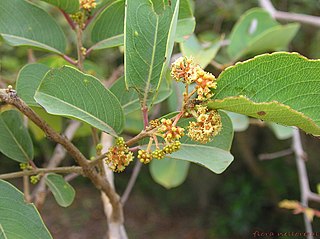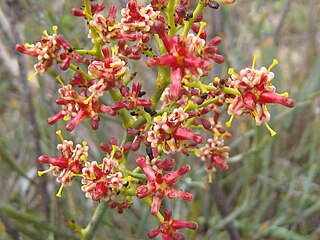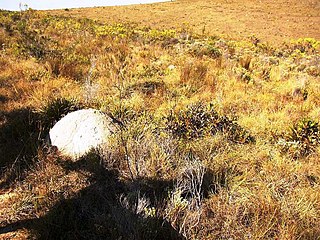
Kalmia latifolia, commonly called mountain laurel, calico-bush, or spoonwood, is a broadleaved evergreen shrub in the heather family, Ericaceae, that is native to the eastern United States. Its range stretches from southern Maine south to northern Florida, and west to Indiana and Louisiana. Mountain laurel is the state flower of Connecticut and Pennsylvania. It is the namesake of Laurel County in Kentucky, the city of Laurel, Mississippi, and the Laurel Highlands in southwestern Pennsylvania.

Endive is a leaf vegetable belonging to the genus Cichorium, which includes several similar bitter-leafed vegetables. Species include Cichorium endivia, Cichorium pumilum, and Cichorium intybus. Common chicory includes types such as radicchio, puntarelle, and Belgian endive.

Pinus contorta, with the common names lodgepole pine and shore pine, and also known as twisted pine, and contorta pine, is a common tree in western North America. It is common near the ocean shore and in dry montane forests to the subalpine, but is rare in lowland rain forests. Like all pines, it is an evergreen conifer.

Kalmia is a genus of about ten species of evergreen shrubs from 0.2–5 m tall, in the family Ericaceae. They are native to North America and Cuba. They grow in acidic soils, with different species in wet acid bog habitats and dry, sandy soils.

Andromeda polifolia, common name bog-rosemary, is a species of flowering plant in the heath family Ericaceae, native to northern parts of the Northern Hemisphere. It is the only member of the genus Andromeda, and is only found in bogs in cold peat-accumulating areas.

Typha latifolia is a perennial herbaceous plant in the genus Typha. It is found as a native plant species in North and South America, Europe, Eurasia, and Africa. In Canada, broadleaf cattail occurs in all provinces and also in the Yukon and Northwest Territories, and in the United States, it is native to all states except Hawaii. It is an introduced and invasive species, and is considered a noxious weed, in Australia and Hawaii. It has been reported in Indonesia, Malaysia, New Zealand, Papua New Guinea, and the Philippines.

Anogeissus latifolia is a species of small to medium-sized tree native to the India, Nepal, Myanmar, and Sri Lanka. Its common names are axlewood (English), bakli, dhau, dhawa, dhawra, or dhaora (Hindi), takhian-nu (Thai), and raam (Vietnamese).

Rosewood refers to any of a number of richly hued timbers, often brownish with darker veining, but found in many different hues.

Banksia sphaerocarpa, commonly known as the fox banksia or round-fruit banksia, is a species of shrub or tree in the plant genus Banksia. It is generally encountered as a 1–2 m (3.3–6.6 ft) high shrub, and is usually smaller in the north of its range. This species has narrow green leaves, and brownish, orange or yellow round flower spikes which may be seen from January to July. It is widely distributed across the southwest of Western Australia, growing exclusively in sandy soils. It is usually the dominant plant in scrubland or low woodland. It is pollinated by, and is a food source for, birds, mammals, and insects.

The putative Wych Elm cultivar Ulmus glabra 'Latifolia' was identified in Audibert's Tonelle (1817) as U. campestrisLinn. [ = U. glabraHuds.] latifolia. The tree is reputed to have originated circa 1750 in or around Mechelen, and to have been widely planted throughout Belgium. A 1912 herbarium specimen from Oudenbosch, however, shows a hybrid leaf labelled Ulmus hollandica latifolia.

Madhuca longifolia is an Indian tropical tree found largely in the central and north Indian plains and forests. It is commonly known as madhūka, mahuwa, mahua, mahwa, mohulo, or Iluppai or vippa chettu. It is a fast-growing tree that grows to approximately 20 meters in height, possesses evergreen or semi-evergreen foliage, and belongs to the family Sapotaceae. It is adaptable to arid environments, being a prominent tree in tropical mixed deciduous forests in India in the states of Odisha, Chhattisgarh, Jharkhand, Uttar Pradesh, Bihar, Maharashtra, Telangana, Madhya Pradesh, Kerala, Gujarat, West Bengal and Tamil Nadu.

Amphitecna is a genus of plants in the family Bignoniaceae.

Palicourea is a plant genus in the family Rubiaceae. It contains about 200 species, which range from shrubs to small trees, and is distributed throughout the New World tropics.

Stirlingia, commonly known as blueboy, is a genus of 7 species in the family Proteaceae, all of which are endemic to Western Australia.

Stirlingia latifolia, commonly known as blueboy, is a plant endemic to Western Australia.

The Cuban moist forests is a tropical moist broadleaf forest ecoregion that occupies 21,400 km2 on Cuba and Isla de la Juventud. The ecoregion receives more than 2,000 mm (79 in) of rainfall annually, and does not have a dry season. Soils are usually derived from quartz, limestone, or serpentinites. Cuban moist forests can be differentiated into lowland forests, sub-montane forests, and montane forests.

Olyra latifolia, commonly known as carrycillo, is a species of bamboo in the grass family Poaceae. It occurs in Mexico, Central and South America, and in sub-Saharan Africa. It is a common species, up to 5 m (16 ft) tall, growing prolifically in rainforests, particularly near the margins.
Alchornea latifolia is a species of tree in the family Euphorbiaceae. It is native to Central and South America, as well as the Caribbean, where its common names include aguacatillo, baconá and chote.

Amphitecna macrophylla, commonly known as black calabash or chaff-bush, is a species of plant in the family Bignoniaceae. It is found in small patches of Mexico and Guatemala. It can reach a height of 15 to 30 feet. It is drought tolerant and is hardy to USDA Hardiness Zone 10b.

Protea foliosa, also known as the leafy sugarbush, is a flowering plant of the genus Protea in the family Proteaceae which is endemic to the Cape Region of South Africa. In the Afrikaans language it is known as ruie-suikerbos.

















